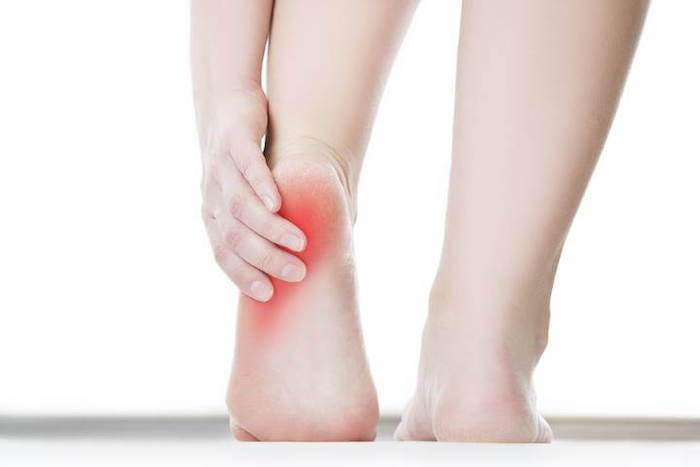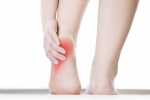
Most Common Cause of Heel Pain
Do your feet hurt when you take those first steps in the morning? Does the sharp pain come back after you sit or stand for a while? You could have plantar fasciitis -- and if so, it’s a good idea to treat it ASAP. If you ignore it, it can change the way you walk and lead to knee, hip, and back problems.
Painful Signs
A tough band of tissue, called your plantar fascia, connects your heel bone to your toes. Plantar fasciitis is when this tissue is irritated. Stabbing pain at the bottom of your foot near your heel is the most obvious symptom, but that pain could start off dull and get worse over time. It may hurt to stretch your foot or press on your arch. You’ll also probably ache more after a workout.
Who Gets It?
Walking and running are great exercises, but doing a lot of either one raises your odds of having this type of foot pain. So do tight calf muscles, flat feet, or high arches. Being overweight, over 40, or having a job that keeps you on your feet for many hours also ups your chances.
See a Doctor
Your doctor will ask about your symptoms and take a careful look at your feet. They also may want to do an imaging test like an X-ray, ultrasound, or MRI (magnetic resonance imaging) scan to get a more complete picture and rule out other problems like arthritis or a fracture.
Slow Down
If you have plantar fasciitis, the tissues in your foot are damaged or torn. Rest is a crucial part of healing -- take a break from activities that put stress on your feet like running, walking (unless absolutely necessary), and aerobic classes. Instead, choose low-impact workouts like swimming or biking.
Cool Down Your Pain
To get relief, try ice. The crushed kind works well because it molds to the shape of your foot. Wrap it in a towel, and put it on your foot for 20 minutes, 4 times a day. (A bag of frozen corn or peas works, too.) You also can freeze water in a small paper cup, then rub it over painful spots for a few minutes, using light pressure.
Medicine
Nonsteroidal anti-inflammatory drugs (NSAIDs) like ibuprofen and naproxen can give your aching heels some short-term relief. You can get them over the counter, or your doctor might prescribe a stronger dose. Take them only as directed: Overuse of NSAIDs can lead to stomach pain or bleeding and kidney damage. They also can react with other drugs you take.
Time to Buy Shoes
If you go barefoot or wear slippers or shoes that are too small, your plantar fasciitis can get worse. Wearing old shoes can do this, too, because they lose their ability to protect and support your feet over time. Your best bet is a new pair of running shoes with thick, well-cushioned midsoles. Flat feet? Look for a pair with good arch support.
Stretch Your Feet and Legs
Exercises that stretch your plantar fascia and Achilles tendon can make your foot feel better. Others that make your lower leg muscles stronger can help stabilize your ankle and heel. Talk to your doctor or a physical therapist to find out which ones would work best for you.
Support Your Feet
Some people who have this condition feel better if they wear a splint at night. This brace gives your foot a gentle stretch while you sleep. You can buy one without a prescription at a pharmacy. You also can use athletic tape on the bottom of your foot to help support your arch. Your doctor can teach you how to put on the tape at home.
Steroids
These medications won’t cure your plantar fasciitis, but they can make you feel better for a while. You usually get them as a shot in your foot, and they work for 3 to 6 months. Your doctor will use a thin needle to inject the drug right into your heel. Your pain should slowly go away over the next few days. Once it does, you may be able to exercise again.
'Shocking' Treatment
Extracorporeal shockwave therapy (ESWT) is a newer way to ease plantar fasciitis pain. Your doctor numbs your heel with anesthesia, then uses a handheld device to send high-energy soundwaves into the most tender area of your foot. This is believed to calm the nerves that send pain signals to your brain and speed up the healing process. But more research needs to be done to prove it works that way.
Surgery
Most heel pain goes away within 12 months, but if nothing has worked for you, your doctor may suggest surgery. A surgeon will cut your fascia (the band of tissue that runs along the bottom of your foot) away from your heel bone. This should stop your symptoms for good, but it does have risks, like nerve damage and infection.
Prevent Pain
Once your feet feel better, you’ll need to do some things to keep them healthy. Stay at a good weight for you. Stretch your legs before you work out. When your shoes get old and worn, buy a new pair that supports your feet. You can also talk to your doctor about shoe supports, like heel pads, to give you some extra cushion.
A Special Rx for Runners
Up to 10% of all running injuries involve heel pain. If you hit the road often, take steps to keep your plantar fasciitis from coming back. Make sure your running shoes match your foot type, increase your mileage and intensity slowly, and try to stay off hard concrete, hills, or unstable ground like a beach.
Precision Pain Care and Rehabilitation has two convenient locations in Richmond Hill – Queens and New Hyde Park – Long Island. Call the Richmond Hill office at (718) 215-1888, or (516) 419-4480 for the Long Island office, to arrange an appointment with our Interventional Pain Management Specialist, Dr. Jeffrey Chacko.













